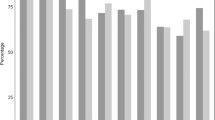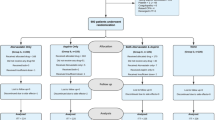Abstract
Objective
Beneficial effects with statin use are increasingly reported in a variety of patient groups. There is in vitro and clinical evidence for its antiinflammatory and immunomodulatory therapeutic roles. We aimed to assess the association between statin administration and mortality in bacteraemic patients.
Design
A retrospective cohort analysis.
Setting
A 300-bed acute general hospital.
Patients and participants
All patients (n=438) requiring hospital care for an episode of bacteraemia during the years 2000–2003 were included. Statin use, patient outcome, and clinical and laboratory variables were collected.
Interventions
None.
Measurements and results
There was a significant reduction in all-cause hospital mortality (10.6% vs. 23.1%, p=0.022) and death attributable to bacteraemia (6.1% vs. 18.3%, p=0.014) in patients who were receiving statin therapy at the time of bacteraemia (n=66). The reduction in all-cause hospital mortality (1.8% vs. 23.1%, p=0.0002) and death attributable to bacteraemia (1.8% vs. 18.3%, p=0.0018) was more pronounced in the patients who continued to receive statin therapy after the diagnosis of bacteraemia (n=56). The apparent mortality benefit persisted after controlling for differences between the groups. Statin use prior to admission was associated with a reduced adjusted hospital mortality rate (odds ratio 0.39; CI 95% 0.17, 0.91; p=0.029), and continuing statin use after bacteraemia increased this effect (odds ratio 0.06; CI 95% 0.01, 0.44; p=0.0056).
Conclusion
This retrospective study demonstrates a significant survival benefit associated with continuing statin therapy in bacteraemic patients. The potential for statins as an adjuvant therapy in sepsis warrants further investigation.
Similar content being viewed by others
References
The LIPID Study Group (1998) Prevention of cardiovascular events and death with pravastatin in patients with coronary heart disease and a broad range of initial cholesterol levels. The Long-Term Intervention with Pravastatin in Ischaemic Disease (LIPID) Study Group. N Engl J Med 339:1349–1357
Ko DT, Mamdani M, Alter DA (2004) Lipid-lowering therapy with statins in high-risk elderly patients: the treatment-risk paradox. JAMA 291:1864–1870
Poldermans D, Bax JJ, Kertai MD, Krenning B, Westerhout CM, Schinkel AF, Thomson IR, Lansberg PJ, Fleisher LA, Klein J, van Urk H, Roelandt JR, Boersma E (2003) Statins are associated with a reduced incidence of perioperative mortality in patients undergoing major noncardiac vascular surgery. Circulation 107:1848–1851
Lindenauer PK, Pekow P, Wang K, Gutierrez B, Benjamin EM (2004) Lipid-lowering therapy and in-hospital mortality following major noncardiac surgery. JAMA 291:2092–2099
Rosenson RS, Tangney CC (1998) Antiatherothrombotic properties of statins: implications for cardiovascular event reduction. JAMA 279:1643–1650
Kwak BR, Mach F (2001) Statins inhibit leukocyte recruitment: new evidence for their anti-inflammatory properties. Arterioscler Thromb Vasc Biol 21:1256–1258
Almog Y (2003) Statins, inflammation, and sepsis: hypothesis. Chest 124:740–743
Liappis AP, Kan VL, Rochester CG, Simon GL (2001) The effect of statins on mortality in patients with bacteremia. Clin Infect Dis 33:1352–1357
Blanco-Colio LM, Tunon J, Martin-Ventura JL, Egido J (2003) Anti-inflammatory and immunomodulatory effects of statins. Kidney Int 63:12–23
Gordon BR (2004) Poor outcomes associated with low lipid and lipoprotein levels. Crit Care Med 32:878–879
Wu A, Hinds CJ, Thiemermann C (2004) High-density lipoproteins in sepsis and septic shock: metabolism, actions, and therapeutic applications. Shock 21:210–221
Tai SC, Robb GB, Marsden PA (2004) Endothelial nitric oxide synthase: a new paradigm for gene regulation in the injured blood vessel. Arterioscler Thromb Vasc Biol 24:405–412
Angus DC, Linde-Zwirble WT, Lidicker J, Clermont G, Carcillo J, Pinsky MR (2001) Epidemiology of severe sepsis in the United States: analysis of incidence, outcome, and associated costs of care. Crit Care Med 29:1303–1310
Vincent JL, Abraham E, Annane D, Bernard G, Rivers E, Van den Berghe G (2002) Reducing mortality in sepsis: new directions. Crit Care 6(Suppl 3):S1–S18
MIMS Online (2004) Prescribing information. Atorvastatin, simvastatin. MIMS Online Australia. Accessed 12 August 2004
Drug Reactions Advisory Committee (2004) Risk factors for myopathy and rhabdomyolysis with the statins. Australian Adverse Drug Reactions Bulletin 23:2
Knaus WA, Draper EA, Wagner DP, Zimmerman JE (1985) APACHE II: a severity of disease classification system. Crit Care Med 13:818–829
Finfer S, Bellomo R, Lipman J, French C, Dobb G, Myburgh J (2004) Adult-population incidence of severe sepsis in Australian and New Zealand intensive care units. Intensive Care Med 30:589–596
Kasal J, Jovanovic Z, Clermont G, Weissfeld LA, Kaplan V, Watson RS, Angus DC (2004) Comparison of Cox and Gray’s survival models in severe sepsis. Crit Care Med 32:700–707
Rice JB, Stoll LL, Li WG, Denning GM, Weydert J, Charipar E, Richenbacher WE, Miller FJ, Jr., Weintraub NL (2003) Low-level endotoxin induces potent inflammatory activation of human blood vessels: inhibition by statins. Arterioscler Thromb Vasc Biol 23:1576–1582
Pruefer D, Makowski J, Schnell M, Buerke U, Dahm M, Oelert H, Sibelius U, Grandel U, Grimminger F, Seeger W, Meyer J, Darius H, Buerke M (2002) Simvastatin inhibits inflammatory properties of Staphylococcus aureus alpha-toxin. Circulation 106:2104–2110
Gabay C, Kushner I (1999) Acute-phase proteins and other systemic responses to inflammation. N Engl J Med 340:448–454
Author information
Authors and Affiliations
Corresponding author
Additional information
Work was performed at Ipswich Hospital (Ipswich) and Princess Alexandra Hospital (Brisbane), Australia.
This article refers to the editorial at http://dx.doi.org/10.1007/s00134-005-2860-5.
The authors have no financial interest in the products discussed in this paper. The authors have not received sponsorship or funding or have any conflicts of interest.
Electronic Supplementary Material
Rights and permissions
About this article
Cite this article
Kruger, P., Fitzsimmons, K., Cook, D. et al. Statin therapy is associated with fewer deaths in patients with bacteraemia. Intensive Care Med 32, 75–79 (2006). https://doi.org/10.1007/s00134-005-2859-y
Received:
Accepted:
Published:
Issue Date:
DOI: https://doi.org/10.1007/s00134-005-2859-y




